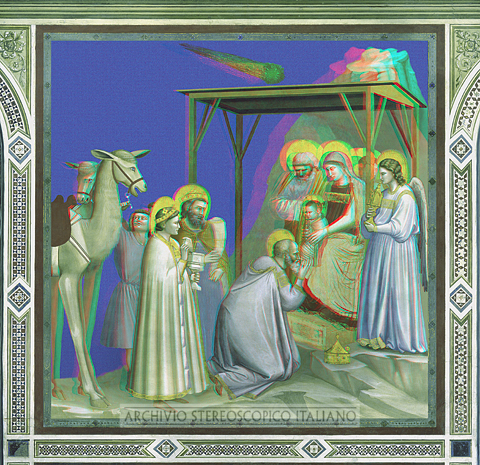

The subtitle of the exhibition: da Giotto a 'Giotto' (from Giotto to 'Giotto'), where as 'Giotto' we mean the probe that ESA (European Space Agency) launched in 1985 in order to study the Halley’s Comet, intends to give credit to the great Florentine painter that around 1305 painted in Padua, in the Scrovegni’s Chapel, what is considered the first representation of a comet in a Magi’s Adoration. In fact in the ancient Christian ichnographic tradition the light that guided the Magi to Jesus’ Hut is portrayed as a star. Also in many Romanic or gothic scenes of the Nativity or Magi’s Adoration a star is shown in the sky, as in the scene frescoed in St. Michael Oratory, in Padua, in 1395 by Jacopo da Verona.
In the Byzantine ichnographic tradition on the contrary the star is described with three rays always downwards, apparently similar to a tail, that nevertheless don’t want to depict a comet, but, symbolically, the Trinitarian concept, stated in 325 A.D. by Council of Nicea.
Why did Giotto at the beginning of the XIV century paint then a comet? The acceptable reasons can be two.
The first one concerns the astronomical knowledge in the Paduan cultural background with which Giotto certainly made contact. If the stars movements were those described by the great Greek-Alexandrian astronomer Tolomeo (II cent. A.D.), the constitution of the universe was that explained in Aristotele’s works (IV cent. b.C.), that for which sky was immutable, nothing new could happen inside of it, and stars were fixed in a solid sphere immensely far. The light in motion which appeared in the sky and guided the Magi had to be therefore a comet, a phenomenon of the atmosphere – this was the belief – where everything could happen, according to the Aristotelian conception.
The second reason is that in 1301 two comets came into sight in the sky, and it is very probable that Giotto saw at least one if not both of them. One of these became famous, after its recurrence in 1682, for the work of the English astronomer Edmond Halley (1656-1742). It is insignificant to define which one of the two was seen by Giotto, but the apparition of the new star gave him the occasion of depicting its naturalistic representation in the scene of the Magi’s Adoration painted in the Scrovegni’s Chapel in Padua.
In the 3D picture: transcription in anaglyph of the conversion from 2D to 3D of the Magi’s Adoration lenticular by Giotto, displayed in the exposition. The realization, made by Antonello Satta, curator of the photo-stereoscopic section, wants to pay homage to him who had great merit in introducing in painting – at his time – the third dimension.
The lenticular image, on a 60 lpi plate of size 32x32 cm, consists of 12 pictures.
Photo album created with Web Album Generator